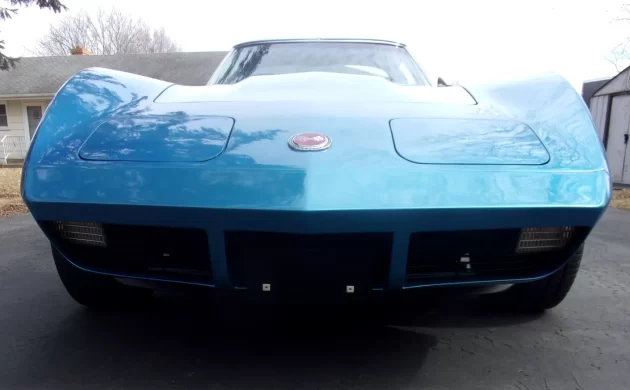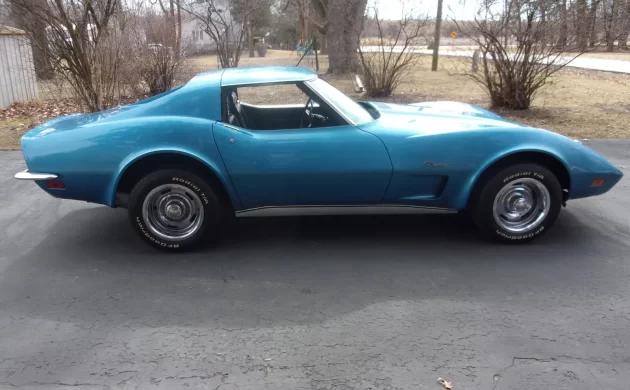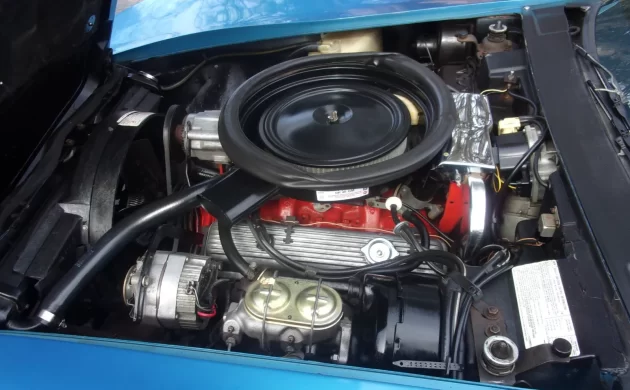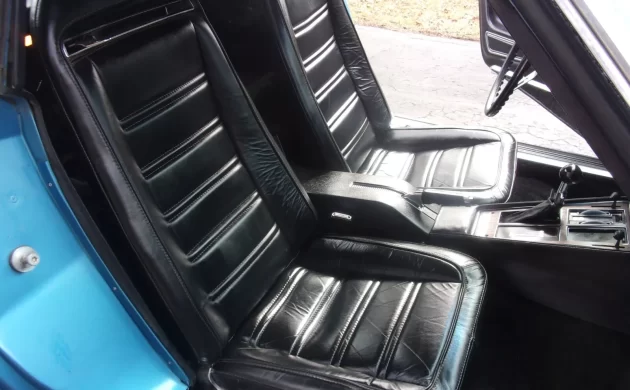What to make of the 1973 Chevrolet Corvette? It looks different coming than it does going. Well, that’s because 1973 was a challenging year for the automotive scene in the U.S. Not only were emission control standards tightening, but there was also a new five MPH bumper requirement – and thus the front and rear Corvette dichotomy. October ’73 saw the manifestation of the Arab oil embargo and its resulting fuel shortages and significant price increases, but that’s a story for another day. Still, Chevrolet carried forward with its iconic fiberglass two-seater Corvette, and today, we have a beautiful, low-mileage example for your review. This medium blue coupe is domiciled in Naperville, Illinois, and it’s available here on eBay for a BIN price of $29,500. There is a make-an-offer option available, too.
The new bumper standard was not quite as clear as one would think. According to Hagerty, “NHTSA Federal Motor Vehicle Safety Standard No. 215 (FMVSS 215), ‘Exterior Protection.’ They took effect in September 1972, so from a practical standpoint, they were enacted by most manufacturers for the 1973 model year. These 1973-only bumpers are often referred to as “2 ½-mph bumpers,” but that’s a bit of a misnomer. Standard 215 required that the bumpers protect safety-related systems and components such as lighting during 5-mph direct front impact tests and 2 ½-mph rear tests.” For ’74, the rear rammer was included in the reg. but the wording required that the bumper protect the body of the car from an impact at any angle, not just a direct front impact. So, the ’73 Corvette ended up with a soft bumper cover, much like that found on most modern vehicles, up front with the rear arrangement continuing with the chrome-plated pieces employed from ’68 until ’72.
And looking at the nosepiece of this ‘Vette, I would have to concur with several auto journalists from back in the day who complemented Chevrolet on the applied rhinoplasty – it’s well integrated. Beyond that, what’s not to like about this car? The Medium Blue lacquer finish (code 922) is still fresh and deep, though the seller mentions that the front bumper has been repainted, and there’s no evidence of seam separation. All in all, this Chevy looks like it just stepped out of 1973! As for the mixed bumper message, it was hardly a sales deterrent as 30K Corvettes found new homes in ’73 – the second-highest volume since its 1953 introduction!
The hot Corvette small block V8, between ’70 and ’72, was the solid lifter LT-1. For ’73, those pesky emission control standards deep-sixed that fabulous high-winding engine and replaced it with the 250 net HP L82. The lower end was pretty much the same but the Holley carburetor and aluminum intake of the LT-1 gave way to the L82’s Quadrajet and cast iron engine topper while hydraulic lifters now actuated the valves. Despite the changes, the L82 was only down five net HP from the ’72 LT-1’s rating of 255. The engine is claimed to be the matching numbers unit and its stamped ID bears out that claim. The seller adds, “Runs and idles perfect and engine has never been out of the car… no engine noise and it sounds like it was new and transmission shifts great with no problems.” A Muncie four-speed close ratio manual transmission makes the rear wheel connection.
The listing states, “Interior looks like new with no holes in seats and dash is perfect with all gauges working and plastic still shines great.” My thought is that the black upholstery is leather and is part of the optional custom interior package but I can’t tell with certainty. Anyway, the entire environment does look fine and nothing seems out of place, though the seller mentions some cracks in the driver-side armrest base – a small matter.
As of recent times, the steel bumper C3s (’68-’72) command a market premium over the soft bumper (’74-’82) editions – though the reasons do extend beyond just bumpers. As for a ’73, well, it’s a half-and-half proposition, but finding one in this condition should lead to a quick sale, I would suspect. Considering that, what’s your thought, at $29,500, priced right or not quite?







Unsure on the price Jim but a beautiful ride ! My 72 had the same armrest issue. I put some black duct tape on. No one noticed and I kind of forgot about.
Sold
Looks well bought. Compared to a lot of other 1960’s and early-1970’s intermediates and performance cars the C3 Corvettes, especially with optional engines and 4spds are a bargain.
Steve R
I’ve always like the ’73. The soft nose extends the hood line forward & down. The cowl induction hood has muscularity like the predecessor LT-1/big block hood (without the fake vents). The simple, but functional fender vents. And it retains the Kamm tail.
Owned one just like this for a week or so in the mid 90’s, the seller failed to disclose accident damage and a rebuilt title. Got him to cancel the deal. Owned a ‘74 convertible and a ‘75 coupe but the ‘73 was always my favorite because of the bumper combo. This one seems nicely bought and not out of line as the C3 is heating up lately.
Tell the site owners that we need more Jim O’Donnell write ups.
Glad you enjoyed it, thx!
JO
My first Vette was a 73. I bought it because it had low miles from sitting a lot, thought this was a great idea. Intro to Vette restoration was an expensive lesson. Bearings in the half shafts, wiring, heater core, AC, starters and on and on and on. It was fun lighting up the tires, though. It was repainted in an iridescent pearl white, and it felt like I was driving the Mach 5. Spent more time under it than driving it, lol.
I believe that you can identify the upholstery by the pattern of the stitching. Vertical stitching is vinyl and horizontal as we see here is leather.
Beautiful ‘Vette.
The last year for anything close to real muscle in a Corvette and this one looks very nice. I just like the chrome bumper C3’s so 72 is my choice for a 70’s Corvette. The ask for this hard top C3 is a little optimistic in my opinion.